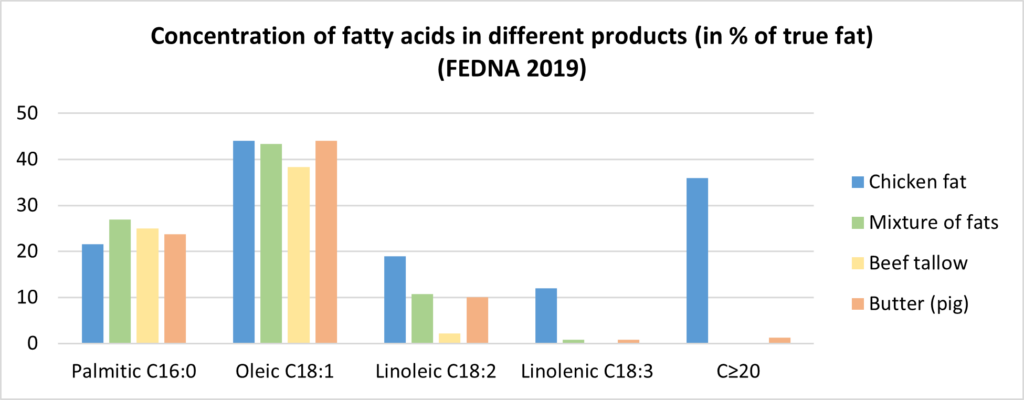The role of fats in poultry feeds
The term fat or oil is used as a synonym for lipids in human and animal nutrition. It refers to the triglycerides with different fatty acids profiles, which are the nutrient with the highest energy content in the diet (Baião and Lara 2005).
Apart from representing one of the main energy sources, fats improve the absorption of fat-soluble vitamins and palatability, and reduce the speed of the gut transit, increasing the time to absorb nutrients (Baião and Lara 2005). Fat also supplies fatty acids considered essential components for the organism.
In poultry nutrition, fat concentration in the diet has an impact on the amount of fat in the carcass. Therefore, fat levels are to be considered in feed formulation, as consumers would rather eat leaner meat.

Types of fat
Fat used for feed can have four different origins: recycled fat from the same species, mixtures of fat from different species, vegetal oils and soapstocks.
Fat from the same species, recycled at slaughter
These fats may also come from the same farm. Antioxidants, such as BHT or BHA, are added to the fats in each recycling process to prevent oxidation. These products cannot be metabolized and accumulate in the animals’ fat cycle after cycle until they impair the liver function. That is why it is essential to evaluate the concentration of antioxidants to avoid toxic levels.
Mix of fats from different species
The fatty acids profile needs to be considered in each mixture, since it will probably differ form the species’ requirements. The energy value of these products will vary greatly, as it depends on the length of the fatty acids chain and their unsaturation degree (Blas et al. 2019). Besides, linoleic acid requirements need to be considered, too.

Vegetal oils
Vegetal fats comprise different types of oils with higher (sunflower, corn or soy) or lower (olive, palm, coconut) unsaturation degree (Blas et al. 2019). Palm oil is one of the most used in poultry, but it easily acidifies and oxidates. Vegetal oils are very common in the European Union (where the use of ingredients of animal origin is prohibited) and countries that produce oils. The fatty acids profile varies greatly depending on the origin, for example, sunflower oil contains high amounts of linoleic acid (63 in % of true fat), while soybean oil has low levels (20.5 in % of true fat).
Soapstocks
Soapstocks are by-products of the vegetal oil industry. They are obtained after refining waste oil to separate triglycerides from free fatty acids, which are responsible from its acidity. These products are less digestible in monogastric animals and, therefore, their energy value is lower that that of fats and oils. Another disadvantage of soapstocks is that, during the refining process, toxic substances such as sodium hydroxide and sulfuric acid, are used and they can be dangerous in case they remain in soapstocks.
Tips to formulate with the recommended fat levels
Fat in poultry diets has different functions depending on the inclusion rate. These functions need to be considered to avoid fatness in the carcass and other problems derived from excessive fat levels.
- 0 to 5% fat inclusion in feed: energy production, it does not accumulate as fat.
- 5 to 10% fat inclusion: it accumulates interorganically, which means that it is deposited on the organ’s surface and helps to increase weight.
- >10% fat inclusion: it accumulates intraorganically, this means that it is deposited inside the cells and can cause liver and arterial problems (fatty liver disease, infarction, and circulatory problems), among others.

In conclusion, increasing fat inclusion levels in poultry diets doe not always correlate with better performance results related to higher weights because, above certain threshold levels, fat has a negative impact on performance and can cause mortality in the farms.
Other factors: seasonal needs
When working on the feed formula, apart from the birds’ general requirements, the variation of these requirements depending on the environmental and productive stage needs to be considered. Hence, energy requirements vary depending in the season: in summer, when temperatures are warmer, birds require less energy (Blas et al. 2019) as they do not use it to produce body heat. That is why we recommend adjusting the energy levels of the feed formula at least once every trimester.
How can we help you?
In Delta Labs, we offer the feed formulation and analysis service to optimize feed composition and adjust it to the requirements of the target species. We can also recommend the most suitable natural antioxidants to prevent problems derived from BHT and BHA inclusion in fat.
We also offer a Diagnostic by Imageservice that includes the evaluation of the problems by a specialized veterinary team and the emission of a report with a presumptive diagnosis and the recommendations to solve the issue.
To use these services, please contact us through our webpage www.globalvetslab.com or email at info@globalvetslab.com
Bibliography
Baião, NC, and LJC Lara. 2005. “Oil and Fat in Broiler Nutrition.” Brazilian Journal of Poultry Science 7(3): 129–41. https://www.scielo.br/j/rbca/a/YBL7TjGmb46VJC5L6PR3qxy/?lang=en&format=pdf.
Blas, C. de, P. Carcía-Rebollar, M. Gorrachategui, and G.G. Mateos. 2019. Tablas FEDNA de composición y valor nutritivo de alimentos para la fabricación de piensos compuestos FEDNA (Fundación Española Para El Desarrollo de La Nutrición Animal). 4th ed. Madrid. http://www.fundacionfedna.org/ingredientes-para-piensos.